Slow Cognition: The Creative Life Curation Framework

What I learned from the Knowledge Curation Project (phase 1)
On Sept 18, 2022, I designed a cover image for a possible book Knowledge Curation, and used it to close the Knowledge Curation project (phase 1).
Now I can move to a new journey: the Life Curation project.
In 2019 I wrote a section about Knowledge Curation in my book Curativity. However, I didn’t write about Life Curation intendedly. I wanted to keep this topic for my second book about Curativity Theory.
In the past three years, I worked on the Knowledge Curation project. After reflecting on the journey, I made the diagram below.

It’s a sandglass!
Yes! A creative life is a process of slow cognition and creative work.
This article aims to introduce the framework as the starting point of the Life Curation project.
Contents
1. First-wave Development
1.1 Explore Widely
1.2 Inquire Deeply
1.3 Crystallize Thematically
1.4 Work Deeply
1.5 Play Widely
1.6 Multi-theme Development
2. Second-wave Development
2.1 The Curated Mind
2.2 Knowledge Curation v.s. Life Curation
3. Third-wave Development
4. Subjectification and Objectification
4.1 Experience 1 / Experience 2
4.2 First-order Activity / Second-order Activity
5. The Need for Generalization
1. First-wave Development
I roughly use five movements to model my journey of the Knowledge Curation project. These five movements form a basic model for understanding Creative Life Curation.
I will use First-wave, Second-wave, and Third-wave to describe the dynamics of the model. All these dynamics can be found in my journey.
1.1 Explore Widely
I started learning theories around 2014. From 2014 to 2018, I read many books and papers about various theories.
I have over twenty years of work experience which can be divided into three stages: the creative stage, the strategic stage, and the innovative stage. At the creative stage, I worked for the advertising and media industry as a creative copywriter and designer. At the strategic state, I worked for pre-IPO stage enterprises as a business strategist and fundraising consultant. At the innovative stage, I worked on making brand-new digital tools and platforms as a researcher and designer.
Before 2014, I spent most of my spare time on digital nonprofit communities as a digital activist. From 2014 to 2015, I transformed my focus from nonprofit activities to theoretical learning. Since then, I have been spending most of my spare time learning ecological psychology, creativity research, and other related subjects.
2014–2020: Ecological Psychology and Creativity Research
2014–2018: Action Science, Activity Theory and Cognitive Science
2018–2019: Practice Theory, HCI, Strategy and Work
2020: Social Theory, Social Media, Information Systems and Platform
The above list indicates that social theory is the newest focus of my learning activity. I’d like to offer more details about my learning journey.
1.2 Inquire Deeply
From 2015 to 2016, I focused on Ecological Psychology. I read many papers about Affordance Theory and Behavior Settings Theory.
From 2015 to 2016, I focused on learning James G. Gibson’s Ecological Approach to Visual Perception and Affordance Theory. I also read Ecological Psychologist Edward Reed’s books and Harry Heft’s Ecological Psychology in Context: James Gibson, Roger Barker, and the Legacy of William James.
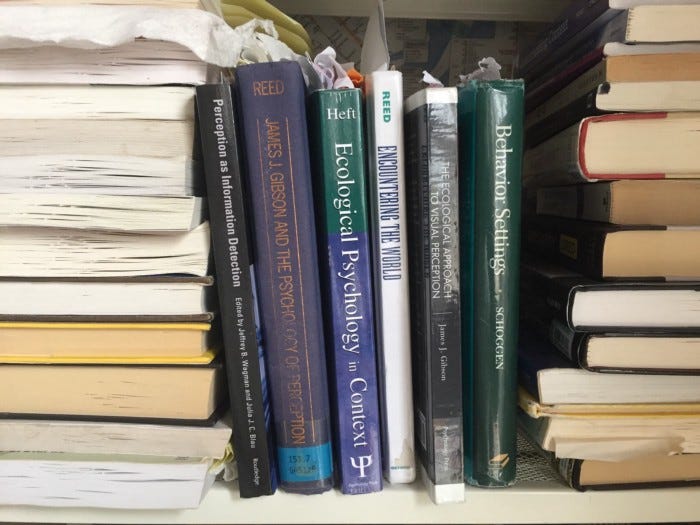
In 2017, I started learning Roger G. Barker’s Behavior Settings theory. In 1989, Phil Schoggen published a book titled Behavior Settings which is a revision and extension of Roger G. Barker’s classic Ecological Psychology: Concepts and Methods for Studying the Environment of Human Behavior (1968). Karl A. Fox wrote a chapter for Schoggen’s edition and mentioned Goffman’s Frame Analysis and other ideas about social practice.

Then, I started reading Goffman’s Frame Analysis and other social theories. Eventually, Social Practice theories became the new focus of my learning journey.
The other focus is Activity Theory. I started learning Ecological Psychology and Activity Theory in 2014. Harry Heft doesn’t directly mention Activity Theory in his book, but he suggests that Lev Vygotsky’s Cultural-historical theory of psychology (which is the major theoretical resource of Activity Theory) is an option for expanding Ecological Psychology to the level of social analysis. Also, some scholars consider Activity Theory as one of the solutions o Social Practice theories.
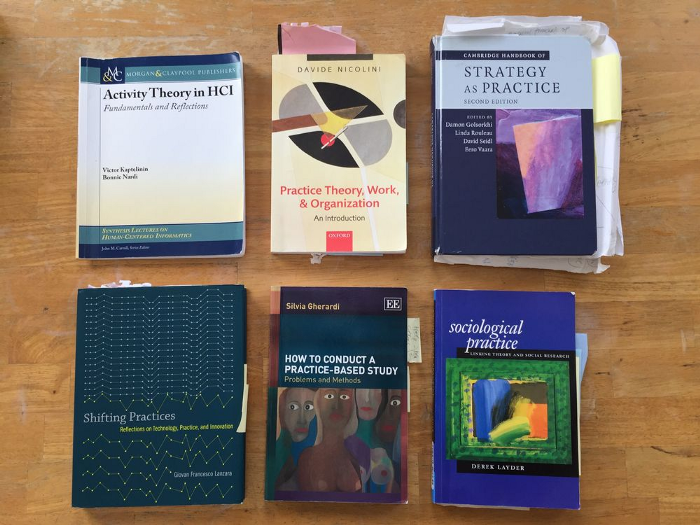
The above picture shows some books about Social Practice Theories from my reading list.
1.3 Crystallize Thematically
I have been working in the curation field for over ten years. I was the Chief Information Architect of BagTheWeb which was an early tool for content curation (We launched the site in 2010). This experience inspired me to make a long-term commitment to the Curation theme.
In April 2018, I reflected on an early project BagTheWeb which is a web content curation tool. I adopted the Activity System model and the idea of “mediated artifact” from Activity Theory to develop a framework for understanding the BagTheWeb project and the Curating activity in general.
In August 2018, I returned to the “Activity Theory — BagTheWeb” project. I started learning Ecological Psychology, Activity Theory, and other theories around 2014. I thought that I need to conduct at least one empirical study with these theories in order to improve my intellectual development. I just thought this is the “one more step”.
From August 2018 to September 2018, I reviewed academic papers about Curation and Practice theories. On Sept 14, 2018, I wrote an outline of a thesis titled Curation Theory: Container, Theme, and Action.
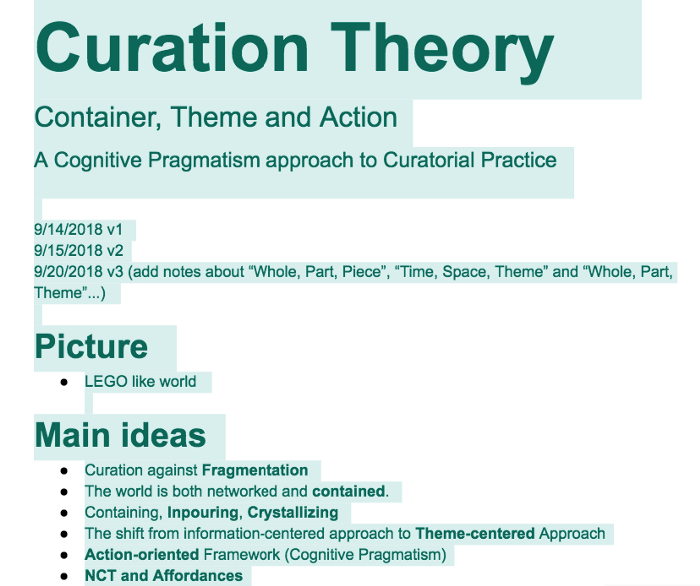
The outlines indicate that I wanted to use the Curating Activity System model as the starting point for building Curation Theory. I also wanted to use the BagTheWeb case study as empirical research.
I expanded the file to a 615-page draft from Oct 2018 to March 2019. The outcome is a book titled Curativity: The Ecological Practice Approach to General Curation Practice.

You can find more details in Slow Cognition: How did I develop Curativity Theory?
1.4 Work Deeply
After March 2019, I continuously worked on revising Curativity and developing the Ecological Practice Approach as a new project. For the direction of Curativity Theory, I am looking for practical applications, for example:
- Knowledge Curation
- Action Curation
- Life Curation
- Platform Curation
I have written a chapter discussing knowledge curation in the book Curativity. For academic knowledge curation, I mentioned Dean Keith Simonton’s chance-configuration theory, Victor Kaptelinin, and Bonnie A. Nardi’s scientific curation case study “curation at Ajaxe”, and qualitative research. For practical knowledge curation, I focus on Cognitive Container since Container is a core concept of Curativity Theory.
Books and courses are typical cognitive containers, however, there are more types of cognitive containers. I highlighted five types of Cognitive Containers:
- Knowledge Card
- Knowledge Framework
- Knowledge Diagram and Chart
- Knowledge Workshop
- Knowledge Sprint
It is not an accurate classification, but a rough recommendation. Also, I suggested that we not only adopt existing types of cognitive containers but also create new types of cognitive containers. Actually, this is the essential point of the Curation Theory. We are shaped by containers and we can make containers too.
In 2020, I decided to apply Curativity Theory to Knowledge Building and I started working on the Knowledge Curation project which led to several books later.
The mission behind the Knowledge Curation project is Connecting Theory and Practice.
The Theory-Practice Gap is an important issue in a wide range of disciplines including education, organization learning, and development, community building, academic development, enterprise R&D, professional service firms (PSFs), etc.
If we can find a good solution to close the Theory-Practice Gap, then we can improve existing social systems of knowledge production, knowledge application, and knowledge management at the individual level and the collective level.
In the past three years, I have developed a set of tools and run several sub-projects.
- 2020: The HERO U framework | The Activity U project
- 2021: The Model of Knowledge Curation and Canvas | The D as Diagramming project
- 2022: The Thematic Space Canvas | The Life Discovery project
- 2022: The Thematic Engagement Toolkit | The Slow Cognition project
The outcome is pretty amazing. I produced various types of knowledge products such as concepts, diagrams, canvases, methods, toolkits, etc. I also wrote articles and edited books.

Now the Knowledge Curation Toolkit (v1.0) has 11 sub-frameworks.
#1: Theme U for Single-theory Curation
#2: WXMY for Interdisciplinary Curation
#3: Hamburger for Contextural Curation
#4: Project I and The HERO I Canvas
#5: WIDENESS for Multi-theory Curation
#6: The Concept Dynamics Framework
#7: The Knowledge Canvas Design Principle
#8: The Means-End Spectrum
#9: The HITED Framework for Methodological Empathy
#10: The Applied Knowledge Curation Framework
#11: The Model of Curated Mind
On Oct 18, 2022, I closed the Knowledge Curation project (phase 1) with the picture below.
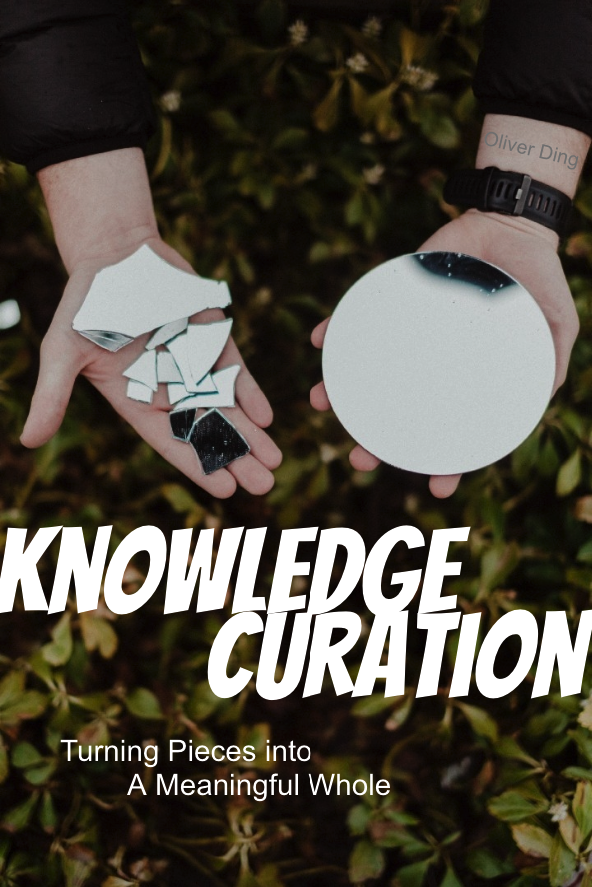
You can find more details in The Knowledge Curation Project (phase 1).
1.5 Play Widely
In 2022, I launched six Knowledge Centers in order to turn my books and tools into learning programs and knowledge services.
- Curativity Center
- Activity Analysis Center
- Creative Action Learning Lab (CALL)
- Platform Ecology Center
- Life Strategy Center
- Thematic Analysis Learning Enterprise (TALE)
On Sept 2, 2022, I used Thematic Landscape Map to visualize the landscape of my “Curativity” knowledge enterprise. See the diagram below. You can find large diagrams and more details in Slow Cognition: Mapping Thematic Landscape (Curativity, 2019–2022).

The Thematic Landscape Map uses three nested circles as a basic model.
- Theme: this inner circle is for displaying Themes and Books.
- Work: the middle circle refers to Projects and two types of Knowledge Frameworks: Abstract Models and Concrete Models.
- Play: the outer circle is about Programs that consider two types of things: Tools and Actions.
While the Theme circle and the Work circle are about knowledge makers’ individual work, the Play circle refers to the collaborative space between knowledge makers and knowledge users.
These three circles also have different significant aspects of complexity.
- Theme: the cognitive aspect of complexity is the primary challenge.
- Work: the material aspect of complexity is the primary challenge.
- Play: the social aspect of complexity is the primary challenge.

The above model is inspired by a model of Project-oriented Activity Theory. It represents three types of Objectification of a Concept:
- Symbolic Objectification: “Verbal” and “Visual”
- Instrumental Objectification: “designed” and “found”
- Practical Objectification: “Branded” and “Shared”
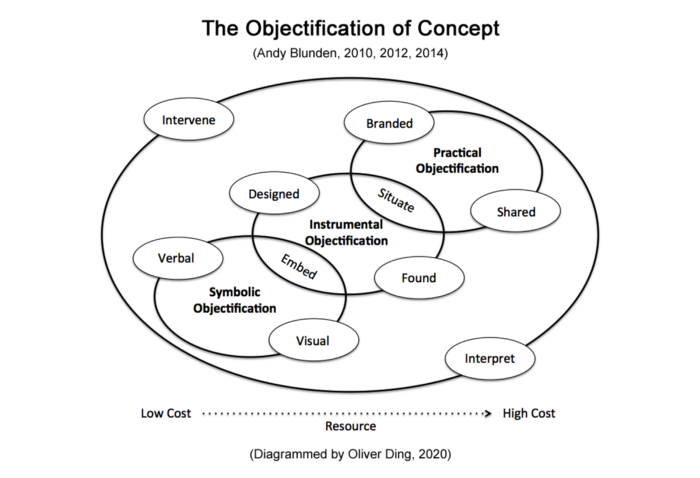
The Creative Life Curation framework is inspired by the Objectification of Concept. A theme can be understood as a concept. In this way, we can use Project-oriented Activity Theory to support the Creative Life Curation framework.
1.6 Multi-theme Development
The Knowledge Curation project is a Single-theme development. I also found Multi-theme Development from a Slow Cognition case study. See the diagram below.
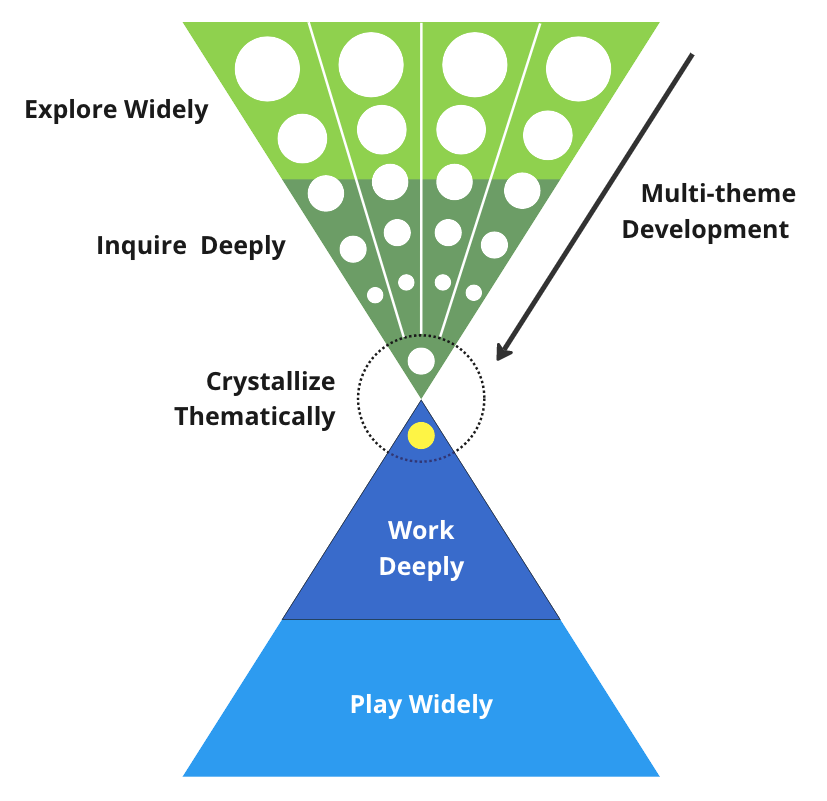
The case study is about a creative journey of developing a meta-theory. The creator developed several unique themes over several years. Finally, he curated these themes together and developed a brand new meta-theory. Later, the new theory was represented in a book.
2. Second-wave Development
The above five movements form a basic model of my creative journey. In fact, there are more dynamics between these movements.
For example, I developed the Model of Curated Mind in the past several months. This is not part of the original Curativity Theory and my 2019 book. Thus, I returned to Explore Widely and Inquire Deeply.
This is an example of Second-wave Development. See the diagram below.
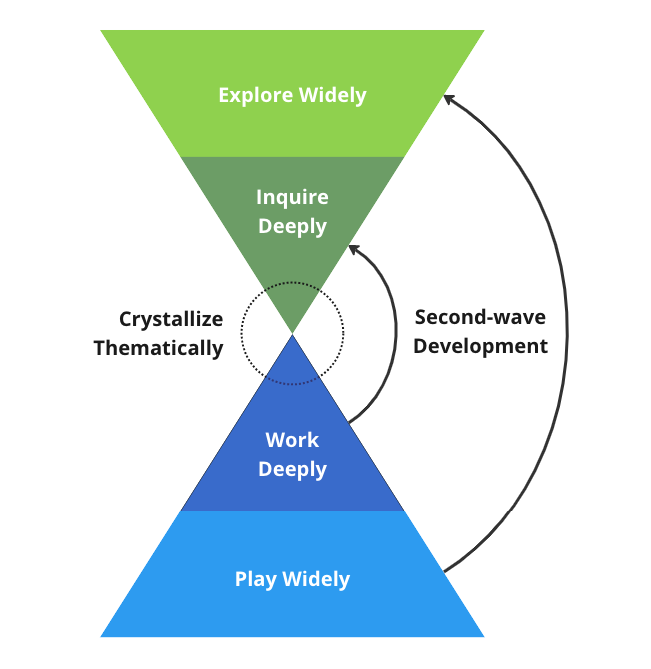
2.1 The Curated Mind
It took several movements to reach the Model of Curated Mind.
First, I worked on closing the D as Diagramming project (phase 1) in Dec 2021. In order to develop a framework to understand the diagramming activity and related social practices, I re-introduced an integrated epistemological framework which four perspectives.
The primary theme of the D as Diagramming project is Diagram and Thought. I realized that most of the theoretical resources behind the framework are adopted from the field of psychological science. Thus, I named the canvas for the D as Diagramming project The Psychology of Diagramming and Beyond. See the picture below.
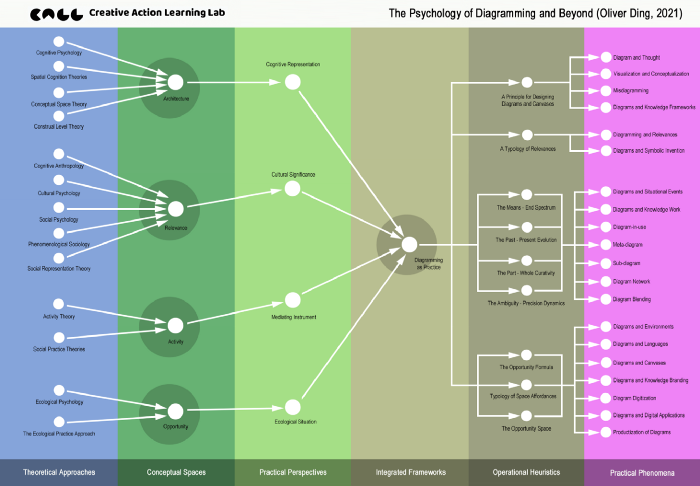
Later, I realized the above canvas is not only about diagramming but also a curated framework of my psychological knowledge because it covers four major psychological theoretical approaches. You can find more details in The Diagramming as Practice Framework.
Second, I worked on developing the Thematic Space Canvas for Developing Tacit Knowledge on Jan 2022. I used the “Flow — Story — Model” metaphor to describe the context of Developing Tacit Knowledge. See the diagram below.

The “Flow — Story — Model” metaphor is also inspired by James G. March (1928–2018) who was an American political scientist, sociologist, and pioneer of organizational decision-making. He mentioned that there are three types of wisdom in his 2010 book The Ambiguities of Experience.
What are the three types of wisdom?
- Models: a model is an abstract cognitive representation.
- Stories: a story is a model too, but it is easy to understand.
- Actions: you just do it, then you get it.
What March suggested roughly echoes three types of social sciences.
- Models: Explanation (such as Systems and Rational Choices)
- Stories: Understanding (such as Culture and Subjective meanings)
- Actions: Intervention (Such as Critical theory and Action Science)
Third, I worked on developing Optimal Context Canvas in March 2022. See the canvas below.
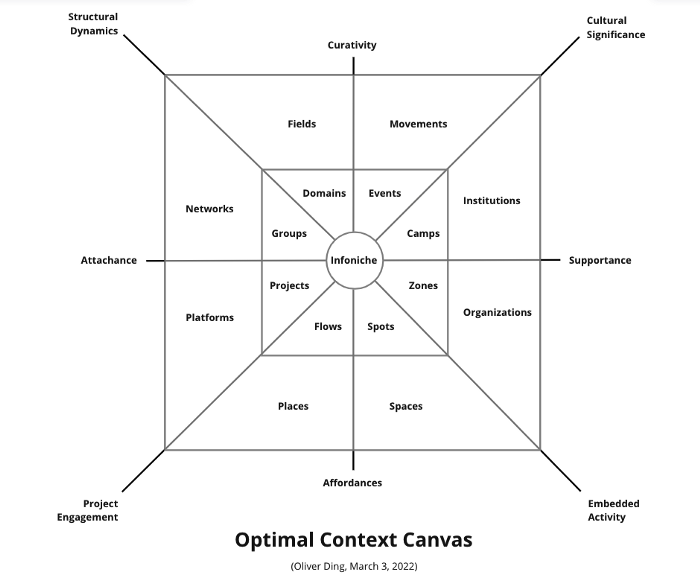
The above canvas has two spaces. While the Inner Space refers to Proximal Contexts, the Outer Space is about Pervasive Contexts. These two types of social contexts were inspired by Self-Determination Theory (SDT).
Later, I coined “Proximal Mind” and “Pervasive Mind” in order to develop an ecological approach to Mind. I also combined these two terms with the above “Flow — Story — Model” metaphor. The result is the following model.
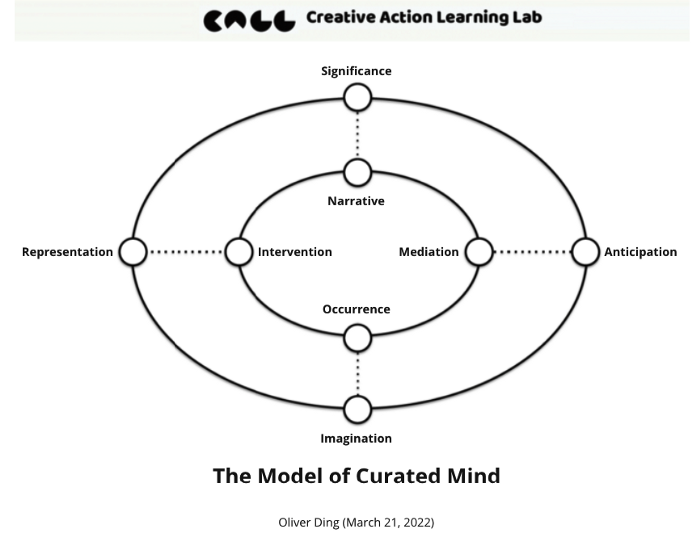
The Curated Mind is a holistic view of the mind and it considers individual actions (that refers to the proximal mind) and collective practices (that refers to the pervasive mind) as a meaningful whole.
The whole process jumped from Objectification to Subjectification.
2.2 Knowledge Curation v.s. Life Curation
Moreover, the dynamics of the model can happen only in the stage of Objectification. Though Curativity Theory can be applied to various fields, I only focused on Knowledge Curation in the past three years.
Now, I will move in the direction of Life Curation. This is the second-wave development of the theme of “Curativity” too. It is the change in the Objectification of “Curativity”. See the diagram below.

3. Third-wave Development
Now the context has been changed. I launched six knowledge centers several months ago.
The Life Curation Project is a collaborative project between Curativity Center and Life Strategy Center.
Originally, Life Strategy Center focused on Life Strategy and the “Anticipatory Activity System” (AAS) framework.
However, Life Curation is a good strategy for life development too.
We see a thematic dialogue in this stage. See the diagram below.
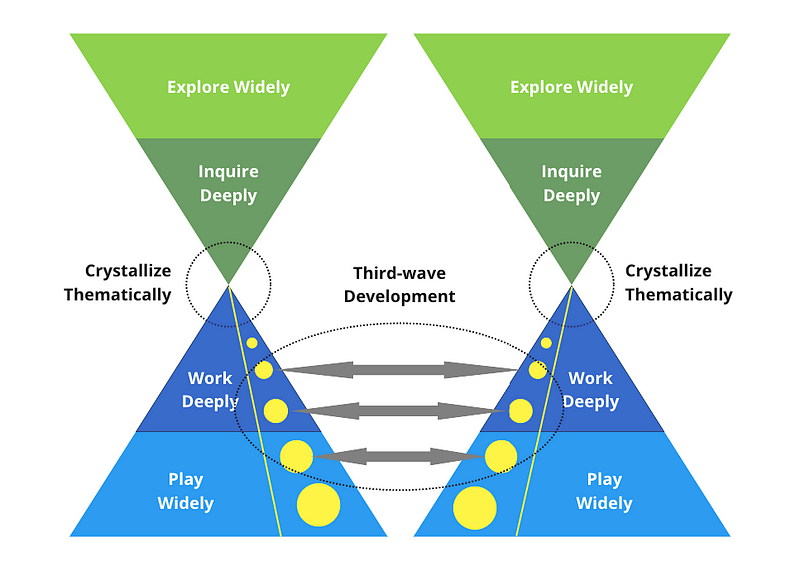
Third-wave Development considers the dynamics of a project network and the creative thematic dialogue. You can see an example in Slow Cognition: The Echoes of A Thematic Dialogue.
4. Subjectification and Objectification
I also divide the process into two tendencies:
Subjectification
- Experience 1: turning the world into a person’s experience.
- This echoes Second-order Activity.
Objectification
- Experience 2: turning the person’s experience into artifacts for the world.
- This echoes First-order Activity.
These terms link to General Curation Framework and the Anticipatory Activity System (AAS) framework.
4.1 Experience 1 / Experience 2
The term “Experience 1 / Experience 2” connects to the General Curation Framework. See the diagram below.
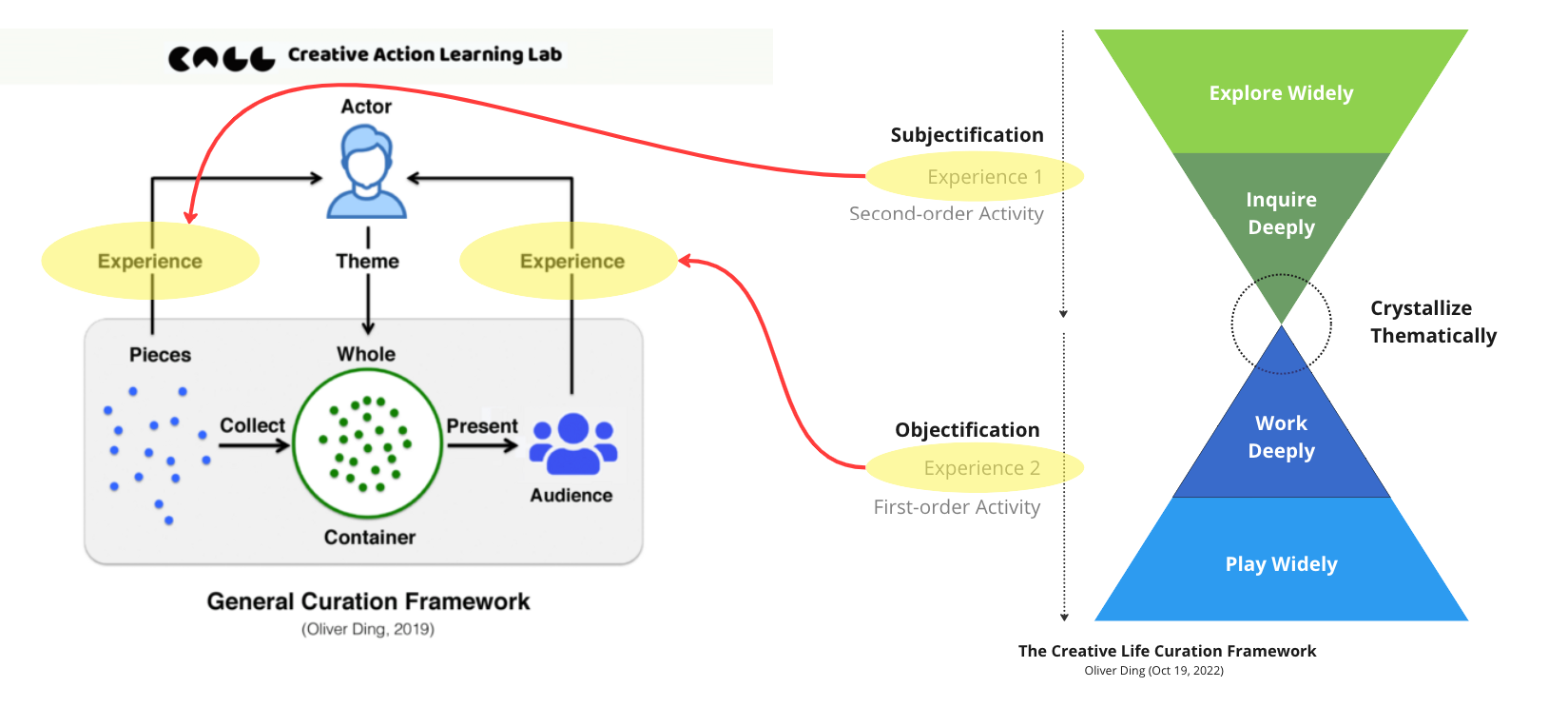
As an application of Curativity Theory, the above General Curation Framework represents the structure and dynamics of general curation practice. The activity of general curation aims to collect pieces of things into a meaningful whole in order to present a theme to a group audience.
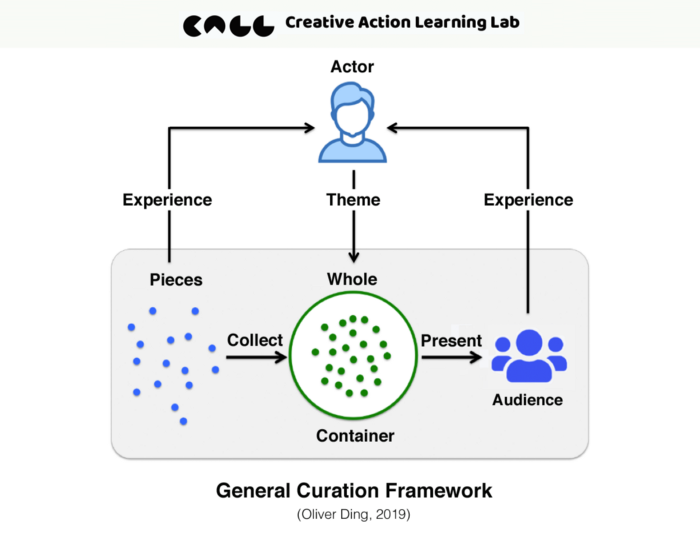
The above diagram highlights several pairs of concepts:
- Pieces v.s. Whole
- Whole v.s. Container
- Collect v.s. Present
- Actor v.s. Audience
- Experience v.s. Theme
I use Experience 1 to refer to turning the world into a person’s experience. For Life Curation Activity, this means Collecting pieces of life experiences.
Experience 2 refers to turning the person’s experience into artifacts for the world. For Life Curation Activity, this means Presenting a new meaningful whole to a group audience.
The key to the transformation between Experience 1 and Experience 2 is Crystallize Thematically which refers to the process of discovering a match between individual life themes and collective cultural themes.
4.2 First-order Activity / Second-order Activity
The term “First-order Activity / Second-order Activity” comes from the Anticipatory Activity System (AAS) framework. See the diagram below.
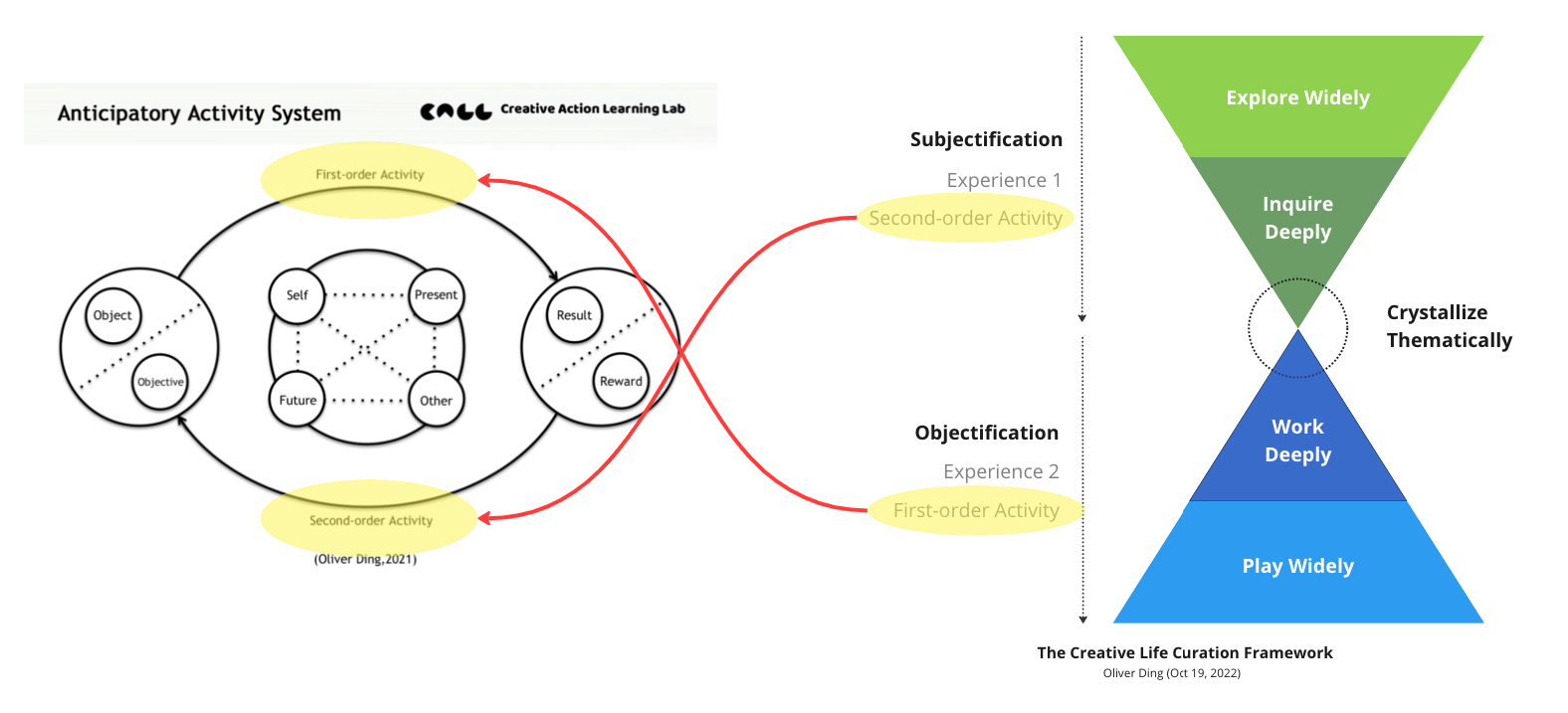
While First-order Activity refers to normal activities which are defined by traditional Activity Theory, Second-order Activity is a specific type of activity in which subjects aim to define objectives and goals for their further activities.

For Life Curation Activity, the process of Subjectification is about turning the world into a person’s experience. The outcome of Subjectification is a match between individual life themes and collective cultural themes.
This match, also called the process of Crystallize Thematically, determines the direction of the process of Objectification.
In this manner, Objectification means First-order Activity while Subjectification means Second-order Activity.
5. The Need for Generalization
The above model is only for reflecting on my personal creative journey. If we want to turn it into a general framework for Life Curation, we need to do more work on generalization.
Generalization is about identifying deep structures, selecting relevant aspects, considering dynamics, and developing concepts. It is the art of making the balance between variant and invariant. See the diagram below.
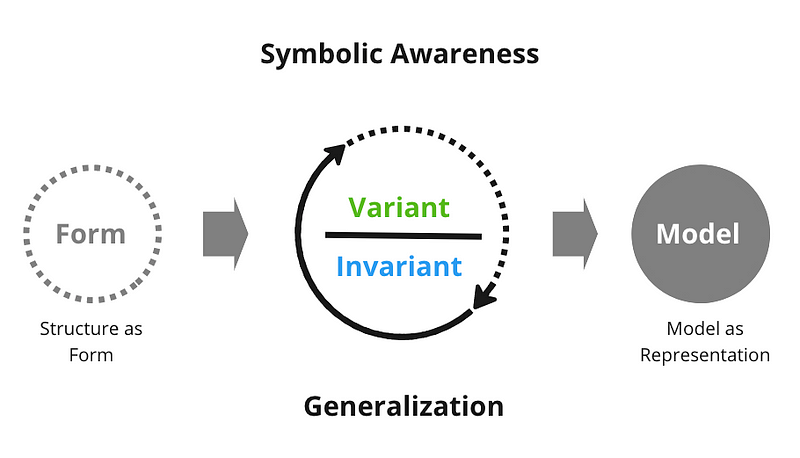
In fact, the above reflection can be seen as a First-order Generalization. I made the Creative Life Curation framework from one case study. The above discussion shows details of my real journey, you can see the “Flow > Story > Model” path from the discussion.
Now we need to use the Model to understand other Stories. We need to take a new journey: the “Model > Story > Flow” path. The key is detaching the Model from the irrelevant details of the original story and attaching the Model to new stories.
For example, the “Crystallize Thematically” movement is about discovering a match between individual life themes and collective cultural themes.

In my creative journey, I coined a new term “Curativity” and wrote a 615-page book. This is my way of “Crystallize Thematically”.
However, the “Crystallize Thematically” movement doesn’t refer to writing a book or developing a new theory only. There are other ways of taking concrete actions of “Crystallize Thematically”.
A creative person can use existing words to name her/his life themes and she/he doesn’t have to write a book. For example, James Currier, a 5-time founder, named his venture capital firm NFX which stands for Network Effects.
Before becoming an investor, James learned Network Effects from his startup Tickle. According to his profile, “James was the co-founder and CEO of Tickle, one of the internet’s first successful user-generated companies. Tickle grew to the 18th largest website in the world with over 150 million registered users — before they were acquired in 2004 by Monster for $110 million. It was during this time that James realized the power of network effects as the core growth driver of both B2B and B2C successes across every vertical.”
In 2017, James found NFX Capital and worked on studying and sharing knowledge about Network Effects. In May 2018, he released the Network Effects Bible.

In October 2022, he launched the Network Effects Masterclass which offers 11 episodes for free.
James’ story is about the theme of “Network Effects” which refers to a significant mechanism of fast-growing startups. In the past 20 years, he went through the whole process of the Life Curation Framework.
The Subjectification Stage
This stage is about turning the world into a person’s experience. In this stage, James developed his life from a startup founder to a successful venture investor. This is about “Explore Widely” and “Inquire Deeply”.
The Turning Point
At this moment, James found a theme that represents his life experience and a strong sociocultural need. The theme is highlighting a significant mechanism for startups in the networked age.
He even used the theme to name his venture capital firm: NFX.
The Objectification Stage
This stage is about turning a person’s experience into artifacts for the world. The term “artifacts” refers to many things. James wrote many articles about Network Effects and made a bible and a masterclass.
This is a great example of discovering a match between individual life themes and collective cultural themes.
